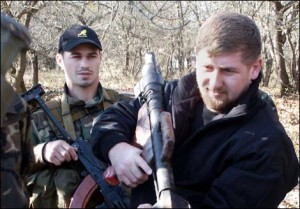 The head of the Chechen Republic, 39-year-old Ramzan Kadyrov, has recently issued a series of public threats against Russian opposition leaders, journalists, and musicians. Kadyrov, a poorly educated former rebel, has long been engaging in aggressive public posturing on his beloved Instagram, but many in Russia have been asking themselves about the reasons for this latest outburst. It appears that these reasons, as is often the case, are of a material nature. Kadyrov and his clan want to continue living in luxury, despite Russia’s rapidly deteriorating economic conditions.
The head of the Chechen Republic, 39-year-old Ramzan Kadyrov, has recently issued a series of public threats against Russian opposition leaders, journalists, and musicians. Kadyrov, a poorly educated former rebel, has long been engaging in aggressive public posturing on his beloved Instagram, but many in Russia have been asking themselves about the reasons for this latest outburst. It appears that these reasons, as is often the case, are of a material nature. Kadyrov and his clan want to continue living in luxury, despite Russia’s rapidly deteriorating economic conditions.
In the last 15 years, the Chechen Republic and its leaders have been kept inside the Russian Federation primarily by the unceasing financial subsidies from the federal center. According to expert estimates, during the period of Putin’s rule more than half a trillion rubles (over $16.5 billion, according to exchange rates at the time) were transferred to Chechnya’s budget. This figure does not include the sums that were issued from the federal budget for the construction and restoration of federal buildings and for salaries to federal employees.
In recent years, with the appearance of new regional “black holes” in the Russian budget—the annexed Crimea and Sebastopol—the volume of federal transfers to the Chechen Republic has been gradually decreasing. Nevertheless, while decreasing in absolute terms, the proportion of these subsidies in terms of percentage has been keeping steady. Thus, in 2014, Chechnya has received some 57 billion rubles in non-repayable transfers from the federal budget; the proportion of these transfers in the republic’s total income was 82 percent.
Naturally, a region devastated by war in the 1990s had to be rebuilt—this is what the money was issued for. Yet 15 years is a reasonable amount of time for restoring the damaged buildings and for building new ones. In the post-war years, not much has been done to create jobs in Chechnya—the unemployment level remains high at 14 percent, and there are no prerequisites for a qualitative change in this situation. However, 20,000 Chechen men serve in various armed groups controlled by Kadyrov; and instead of constructing industrial plants, Chechnya, according to local residents, is constructing expensive sport complexes, skyscrapers, mosques, vacation retreats, and restaurants. Meanwhile, few people are willing to start a business in Chechnya against the backdrop of extortions, lawlessness, and fear for one’s own security.

The numbers from official statistics fail to convey the reality of Chechnya, where Kadyrov essentially rules like an absolute monarch. He is, of course, personally devoted to the “supreme ruler,” Vladimir Putin, and he tries to underline this devotion regularly the way he can, in accordance with his education and upbringing. Putin’s reaction to Kadyrov’s latest statements is also telling: he cannot but back up his “favorite.”
The present-day Chechnya is entirely dependent on the decisions made personally by Putin and Kadyrov, and, for now, they are still beneficial to each other. Yet such a situation is extremely unstable: any serious conflict between the two men can lead to disaster—a new armed conflict, the economic, political, and social preconditions for which have already been established.





